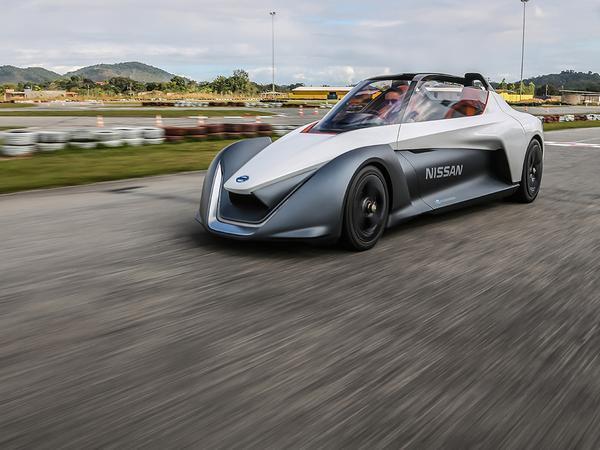Nissan BladeGlider: Review
The EV we really, really want Nissan to build

But your author got behind the wheel at the Goodwood circuit during the Festival of Speed. While everyone was clattering up the hillclimb in their noisy V8s and V12s, I glided silently for lap after lap in something that looked, sounded and felt like the immediate future; like the here and now, in fact. And then the man from Nissan put the kibosh on my flight of fancy and said "maybe in 10 or 15 years, but not now."
"We just want you to see and feel the potential" they said. "We wanted to demonstrate to enthusiasts that EVs are the answer to driving enjoyment." So they did all that, and we agreed, and then they whipped it away from under our noses.
Anyway, what does a proper electric sports car feel like to drive? Well, just look at it. Here is a car built for fun. Echoing Nissan's Le Mans DeltaWing car, it's shaped like a futuristic arrow, with a narrow front track and much wider rear, which gives it an aero advantage as well as some funky rear-wheel-drive cornering characteristics, more of which in a min. Huge dihedral doors, hinged at the rear of the car, cut off at waist height for even more drama.
Inside, that singular central driver's seat puts you at the heart of the action: you could be in a 2025 IndyCar race. When you're doing laps under instruction, it's a bit weird because the instructor's legs stretch down your lefthand side, but it's all part of the other-worldly experience.
The seats are covered in a textured black fabric with an epoxy resin coating for more grip, and there are two colour trims on offer - green and orange - which splash big accents of colour round the cockpit.
The driver's controls are all on the steering wheel: indicator buttons and two manettino switches, one to control the drive mode and one for variable amounts of traction. Flappy paddles add or subtract regenerative braking, although even in its maximum setting, we're not talking Tesla-style retardation, which is a good thing: the driver remains fully in control of braking, as is only proper in a sports car. Behind the wheel, the digital screen displays speed, battery charge, regeneration mode and torque mapping.
Out on track, you do nothing but fall further in love with this car. The silent drivetrain takes on a different vibe in a performance-led EV: combined with that open canopy, you have the sensation of gliding (that name's not all in vain then), and more chance to hear what the tyres are up to. It's a different way to surmise your speed round the track: no roaring revs, but an increasing whirr and more wind. I'd need more time to tell you whether I loved it or not: I think I missed gear changes more than anything.
Thankfully there's a lot of feedback through the chassis and steering to keep you involved in the experience: Nissan partnered with Williams Advanced Engineering for this prototype, so the handling is a little more, er, dynamic than that of the Leaf. The suspension is double wishbones all round, and it's a rewarding, pin-sharp drive. The rear tucks in or swings wide, depending on the torque setting you've selected: off, agile or drift mode. A positive torque vectoring system applies more torque to the outside wheel if it detects understeer. Even with no slack dialled in however, you've still got a lively chassis to play with: that wheelbase feels shorter than it looks and the rear tucks neatly in at the apex: it's a very linear, pretty idiot-proof drive.
Goodness knows why Nissan thinks we're not ready for a £30k electric sports car: this is the week Volvo has announced batteries in all its cars by 2019, France has set a date to abolish petrol and diesel engines and the Government has been charged with massively ramping up the infrastructure, with charging points in every one of the country's 8,500 fuel stations. Also, you'd pay way more than that for a dull electric saloon. Andy Palmer, CEO of Aston, called this car the "anti-establishment electric sports car" when he was at Nissan, and that was a fair while ago. He's right: it is the perfect antidote to every bog-boring Tesla, Nissan, Hyundai and Toyota EV out there.
For the love of god, change your minds Nissan and build the bloody thing.
NISSAN BLADEGLIDER PROTOTYPE
Engine: 200kW battery, 2 x 130kW motors
Transmission: N/A, rear-wheel-drive
Power (hp): 268
Torque (lb ft): 521
0-62mph: est under 5.0sec
Top speed: 115mph
Weight: 1,300kg
MPG: N/A
CO2: N/A
Price: circa £30,000
Gassing Station | General Gassing | Top of Page | What's New | My Stuff











